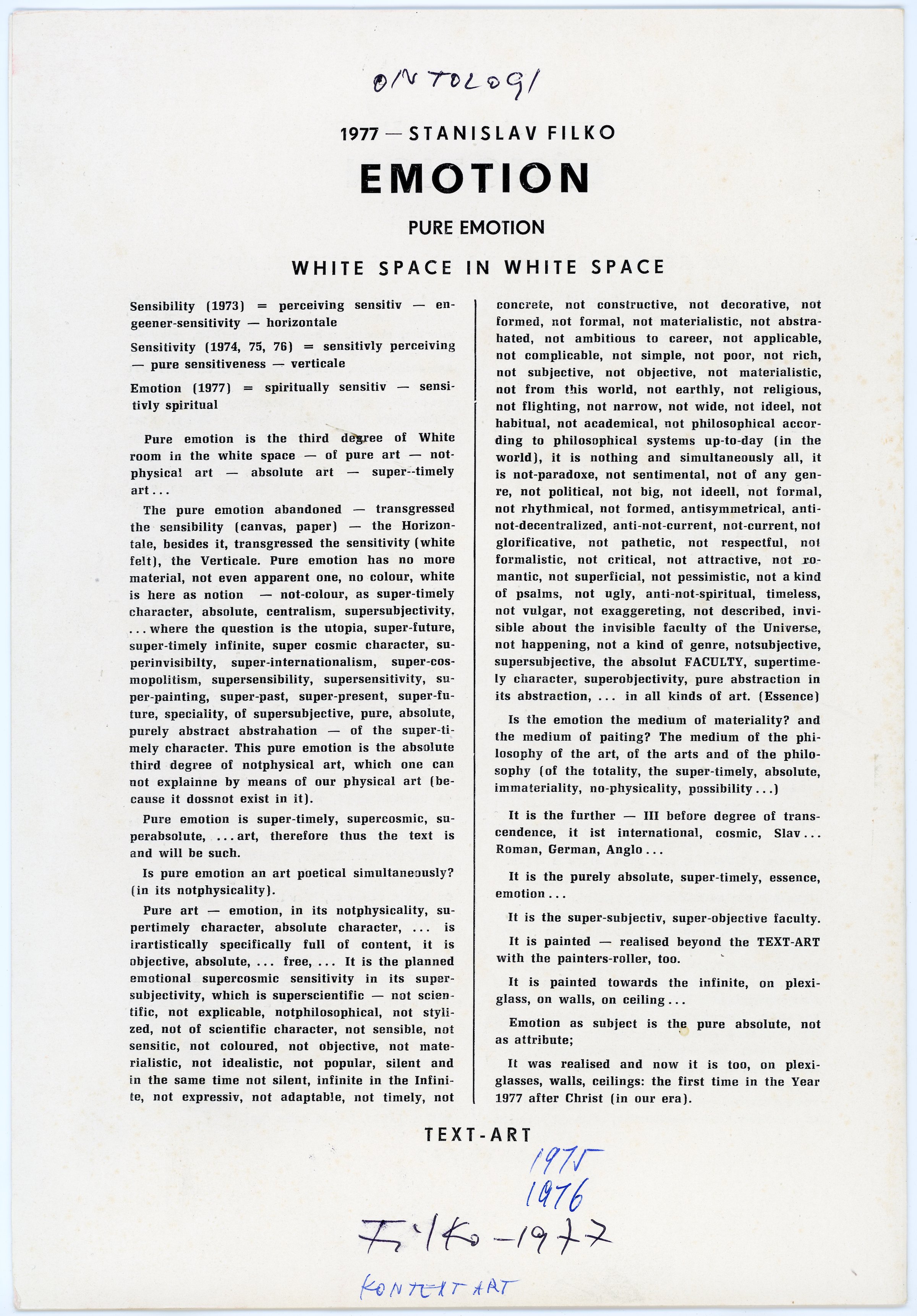Text-art
Basement Gallery

EMÓCIA – EMOTION (Text-art), 1977
Pen, print, felt-tip pen
29×40cm
Courtesy The Slovak National Gallery, Bratislava
In the course of the installation White Space in White Space (1973−76) Filko commenced with a new form of text production, Text-art. An important first step was taken in the White Space in White Space MANIFESTO (1973), which he published together with Miloš Laky and Ján Zavarský to accompany the installation. This manifesto was issued in four different languages at the same time, and it follows in the stylistic tradition of Kazimir Malevich, with very clearly formulated proclamations that are a linguistic companion to the dematerialization of art.
In the manifesto, Filko, Laky, and Zavarský proclaim absolute art, by means of which they wish to step beyond the limits of the material world and to get as close as possible to concepts like emptiness and infinity. These convictions are very clearly expressed and used by the artists to delineate and affirm their position. Absolute art is seen in the manifesto as the expression of “pure sensitivity,” and then further developed as such in the publication White Space in White Space, Pure Sensitivity (1974−75) in nine languages. According to the artists, pure sensitivity cannot be explained, so that its proclamation in language becomes a paradox text. Pure sensitivity should be realized by artistic action, as “pure sensitive art.”
These important texts are the starting point for Filko’s later independently written Text-art works, by means of which he transferred his earlier textual production into his own White Ontology phase and also reevaluated it. Filko initiated his independent work here with his performative concept of EMÓCIA – EMOTION (Text-art) (1977), but was also still drawing on questions concerning materiality and transcendence in art. He uses the concept of “pure emotion” as a further (third) form of transcendence.
A larger shift came with the texts TRANSCENDENCE (1978) and TRANSCENDENCJA I., II. (1979), where he understood the essential element of the transcendent in art increasingly as an expression of his principle of the artistic ego. Here a critical view is called for, as this turns out to be a patriarchal perspective in which the “absolute existence of a man” becomes an all-encompassing principle of artistic creation. Filko himself developed a new self-awareness through his work on texts, further establishing his artistic identity.
The text MEDITATION TRANSCENDENTAL (Text-art) (1980) is soberer in comparison to the other works. Filko summarizes his entire text-art production of the 1970s and derives abstract concepts from it, providing systematic definitions. Filko developed his Text-art through his whole career in parallel to his production of artworks, thereby strengthening his theoretical position and also then establishing his Archive SF.
Stano Filko, Miloš Laky, Ján Zavarský, White Space in White Space MANIFESTO / Biely priestor v bielom priestore MANIFESTO, 1973
Paper, copy, photographs
A4 folded
SENSITIVITY (Text-art) / SENZITIVITA (Text-art), 1976
Offset print, pen, paper
30 x 13,4 cm
EMÓCIA – EMOTION (Text-art), 1977
Pen, print, felt-tip pen
29 x 40 cm
Courtesy The Slovak National Gallery
TRANSCENDENCE / TRANSCENDENCIA, 1978
Print, pencil, pen, paper
23,5 x 18,1 cm
Courtesy The Slovak National Gallery
TRANSCENDENCJA I., II. / TRANSCENDENCE I., II., 1979
Print, pencil, pen, felt-tip pen, paper
19,1 x 35,3 cm
Courtesy The Slovak National Gallery
MEDITATION TRANSCENDENTAL (Text-art) / TRANSCENDENTÁLNA MEDITÁCIA (Text-art), 1980
Offset print, paper
60 x 41,8 cm
Courtesy The Slovak National Gallery
All works if not otherwise stated Courtesy Linea Collection, Bratislava; Layr Vienna